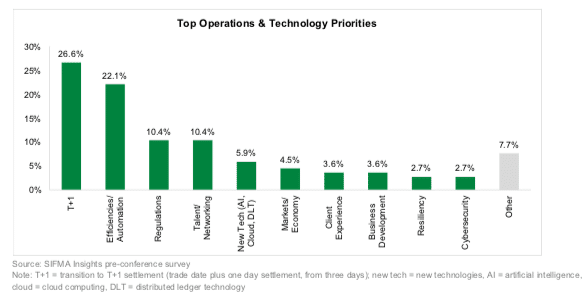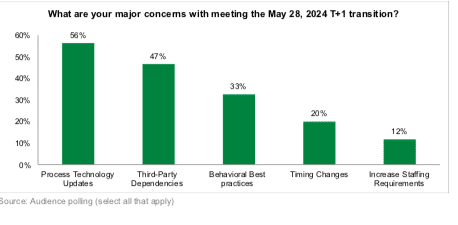Traders Magazine spoke with Allen Greenberg, COO of Matrix Executions, which won Best Options Trading Technology Provider at the 2023 Markets Choice Awards.
Please tell us about your trading solutions for option traders.

Matrix solutions for options traders cut a wide swath, offering very sophisticated solutions for almost all professional options traders. First and foremost comes our electronic offering, led by our proprietary front ends – Matrix Pro for buy-side users, and Matrix Elite (more sell-side focused). Matrix has certified with most leading EMS/OMS front-ends in the industry, allowing firms to connect with us quickly and easily. Providing that cross-functionality is hugely important today. The pièce de resistance of Matrix’s electronic offering is our proprietary algo rack. Matrix’s algos are highly-adaptable and agile, allowing us to collaborate with clients to completely customize our offering to their needs, essentially designing a bespoke solution for each user/client. Matrix’s High-Touch offering provides added expertise for traders requiring that level of service via Matrix brokers on the BOX floor and in Cboe’s SPX pit. Our HT teams assist traders in price discovery and price improvement through our network of liquidity providers, and uniquely, are fully integrated with our electronic offering.
What are the current options trading trends?
The biggest trend is the expansion of FLEX options, where we’ve been active for some time. The number of firms initiating FLEX option trades has expanded significantly, leading to a proliferation of liquidity-providing/market-making firms entering the arena. The growth of this type of product points to a longevity in what was once a very niche market.
How does Matrix Executions differentiate in a competitive landscape?
A few things set us apart from competitors, experience being number one. We bring 40 years of industry experience to the table. We have been traders, brokers, developers since options were in their infancy and have stood in our client’s shoes. Our access to trading expertise, deep industry relationships, and extensive market structure knowledge is unparalleled. Technologically, Matrix’s algo stack, which is completely customizable, delivers a fully tailored offering for each user/client. To supplement these high-performance algo routing capabilities, we also offer ultra-low latency DMA routing.
What are your long-term objectives and ambitions?
Our long-term objectives have remained constant. Since day one, Matrix’s goal has been to provide an innovative product line at a competitive price in an area where, traditionally, there haven’t been many choices. We’re committed to continuously improving our products, HT offering, and delivering a white-glove service client experience – our own experience and the team we have put together have gone a long way to helping us achieve those goals.
What strategy are you using to improve clients’ experience for your business?
Matrix strives to ensure an environment of innovation and collaboration within our team, but more importantly, with our clients. We welcome and encourage open, continuous communication and evolution in our business. We take each client interaction/outcome as an opportunity for growth and improvement vis-a-vis tools and client experience. We handle our technology in-house and oversee client trading lifecycles from start to finish – the capstone of Matrix’s holistic, full-service client approach. Internally, we provide training (and cross-training) within all areas of the organization to ensure a superior experience for users. For instance, while a salesperson may never be a developer (or vice-versa), each side’s understanding of the other’s processes and stress points leads to greater collaboration, better understanding of issues, and ultimately, a better client experience.
What are recent accomplishments for Matrix Executions?
This year, the most obvious would be Matrix receiving the Markets Choice Award for “Best Options Technology Provider”. Matrix has also been shortlisted as a “Top Ten Trading Solutions Provider” of 2023 by Financial Services Review Magazine. That said, it would be remiss of us not to mention just the overall growth Matrix has seen since our inception in 2018 – in terms of our team, range of solutions, and number of clients.
What are your current initiatives at Matrix Executions and what can we expect from Matrix Executions in the nearest future?
One initiative we’re currently working on is a first-of-its-kind system for use with FLEX options. Our clients have mentioned that current processes for trading FLEX options are slow, tedious, and labor intensive – a completely disjointed workflow leading to inefficiencies and quite error prone. To address this, we are building a system that will seamlessly streamline the entire process, from pricing options, sourcing liquidity, execution, reporting, to audit trails, etc.
Another initiative is focused on complex orders and the Complex Order Books at exchanges supporting them. A challenge for many traders is that each exchange has its own set of rules and is not necessarily required to honor better prices at other exchanges when it comes to complex orders. Matrix is in the process of building a hybrid system that not only can trade displayed complex orders (within the COBs), but can trade implied “leg” prices across multiple exchanges to give traders the best pricing possible.
Matrix continues to add to its options liquidity sourcing capabilities, both through further integrations of price discovery/liquidity sourcing behaviors into our options strategies and via the expansion of our liquidity pool destinations.











Policymakers Should Shelve Market Structure Proposals and Focus on What Really Counts for Retail Investors
By Kirsten Wegner, CEO of the Modern Markets Initiative
As the House Financial Services Committee reconvenes at a hearing this Thursday to look at the nation’s equity market structure, there’s one looming question that is the elephant in the hearing room: What are the real problems for investors that SEC Chairman Gary Gensler should try to fix?
New data in a study released by the Modern Markets Initiative definitively indicates that U.S. markets are the envy of the world, and the proof points make for a long list. Stock trading has never been more inexpensive, nor the speed of execution so immediate, than in today’s modern markets. Bid-ask spreads have narrowed by half over a decade, yielding 30% more lifetime retirement savings in modern markets. A middle-class investor can retire years earlier as a result of market efficiencies, according to the report, and a mid-size state pension fund saves over $290 million a year each as a result of low-cost trading. Even 529 plan participants in a mid-size state, for example, saving for education reap $549 million a year in savings.
Chair Gensler has admitted that the U.S. equity markets are the “gold standard” of the world. It is true that the markets must evolve over time, and they can always be improved incrementally. However, the cost of retail trading is at historic lows (typically commission-free at most major retail brokerages), and investors can trade whenever they want. Retail investors in this country have never had it better.
With their limited time and resources, regulators and lawmakers should focus on areas where retail investors need bipartisan attention, including:
While it is positive for the SEC and its chair to look at potential improvements in the U.S. equities markets, it would be wise to ensure that rule changes spotlight areas most in need. Lawmakers and regulators should focus attention on crypto, AI, and the future of fintech – emerging areas that demand consideration now so that investors are protected, there is regulatory clarity, and the U.S. remains the envy of the world for the innovation economy. The future of retail investors is inextricably linked to America’s competitive future.